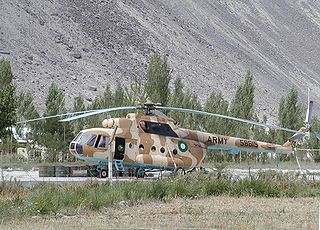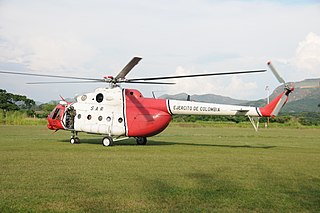
The Sikorsky UH-60 Black Hawk is a four-blade, twin-engine, medium-lift utility military helicopter manufactured by Sikorsky Aircraft. Sikorsky submitted the S-70 design for the United States Army's Utility Tactical Transport Aircraft System (UTTAS) competition in 1972. The Army designated the prototype as the YUH-60A and selected the Black Hawk as the winner of the program in 1976, after a fly-off competition with the Boeing Vertol YUH-61.

The Mil Mi-24 is a large helicopter gunship, attack helicopter and low-capacity troop transport with room for eight passengers. It is produced by Mil Moscow Helicopter Plant and was introduced by the Soviet Air Force in 1972. The helicopter is currently in use by 58 countries.

The Eurocopter AS532 Cougar is a twin-engine, medium-weight, multipurpose helicopter developed by Eurocopter. The AS532 is a development and upgrade of the Aérospatiale SA 330 Puma in its militarized form. Its civilian counterpart is the Eurocopter AS332 Super Puma. The AS532 has been further developed as the Eurocopter EC725.

The Sikorsky CH-53E Super Stallion is a heavy-lift helicopter operated by the United States military. As the Sikorsky S-80, it was developed from the CH-53 Sea Stallion, mainly by adding a third engine, adding a seventh blade to the main rotor, and canting the tail rotor 20°. It was built by Sikorsky Aircraft for the United States Marine Corps. The less common MH-53E Sea Dragon fills the United States Navy's need for long-range minesweeping or airborne mine countermeasures missions, and performs heavy-lift duties for the Navy. The Sikorsky CH-53K King Stallion, which has new engines, new composite rotor blades, and a wider aircraft cabin, is set to replace the CH-53E and is beginning to enter service in the 2020s, but most of the Super Stallions are still in service as are the MH-53E Sea Dragons.

The Mil Mi-8 is a medium twin-turbine helicopter, originally designed by the Soviet Union in the 1960s and introduced into the Soviet Air Force in 1968. It is now produced by Russia. In addition to its most common role as a transport helicopter, the Mi-8 is also used as an airborne command post, armed gunship, and reconnaissance platform.

The Mil Mi-17 is a Soviet-designed Russian military helicopter family introduced in 1975 (Mi-8M), continuing in production as of 2021 at two factories, in Kazan and Ulan-Ude. It is known as the Mi-8M series in Russian service. The helicopter is mostly used as a medium twin-turbine transport helicopter, as well as an armed gunship version.

On 19 August 2002, a group of Chechen fighters armed with a man-portable air-defense system brought down a Russian Mil Mi-26 helicopter in a minefield, which resulted in the death of 127 Russian soldiers in the greatest loss of life in the history of helicopter aviation. It is also the most deadly aviation disaster ever suffered by the Russian Armed Forces, as well as its worst loss of life in a single day since the 1999 start of the Second Chechen War.

The Myanmar Air Force, known until 1989 as the Burmese Air Force, is the aerial branch of Myanmar's armed forces, the Tatmadaw. The primary mission of the Myanmar Air Force (MAF) since its inception has been to provide transport, logistical, and close air support to the Myanmar Army in counter-insurgency operations. It is mainly used in internal conflicts in Myanmar, and, on a smaller scale, in relief missions, especially after the deadly Cyclone Nargis of May 2008.

The 2007 Shatoy Mi-8 crash occurred on April 27, 2007, when a Russian military Mil Mi-8 helicopter carrying special forces troops and officers crashed in mountainous terrain in southern Chechnya, killing all 20 people on board.

The Táchira helicopter crash was the loss of a Venezuela Army helicopter and its 17 occupants on 3 May 2009.

The 2009 Pakistan Army Mil Mi-17 crash occurred on July 3, 2009, in the Federally Administered Tribal Areas of Pakistan. A Russian-manufactured Mil Mi-17 transport helicopter of the Pakistan Army crashed in Orakzai Agency. According to a source within the Army the crash was due to a technical fault. Some sources reported local people attributing the crash to militant activity. The crash site was Chapar Feroze Khel, 20 kilometres (12 mi) from Peshawar, on the border of the semi-autonomous Orakzai and Khyber tribal agencies. The area is remote and also full of militants, which hampered the rescue efforts.

A Mil Mi-17 of the National Army of Colombia was reported missing after taking off from the city of Quibdó on 26 June 2016. The wreckage of the helicopter was found the following day in mountainous terrain in the department of Caldas, 180 km north-west of the capital city Bogotá. It was the third helicopter crash in Colombia in 2016, and with seventeen killed was the worst accident in eleven years for the Colombian military.












